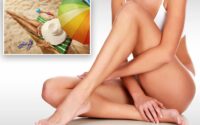Influencer rips ‘harmful’ TikTok food-sharing trend: ‘Fell into the trap’
“I am not going to tell you what I eat in a day.”
Aussie influencer Laura Henshaw, 31, has officially called out the trend of sharing what you eat.
“It is harmful. I struggled with disordered eating for two years, and I fell into the trap of consuming this type of content,” she said.
Henshaw pointed out that even if we all ate the same thing, our bodies wouldn’t all look the same, and she found the sharing to be less about food inspiration and more about “body aspiration.”
There’s been a recent resurgence of influencers and famous people sharing exactly what they eat within a 24 hour period.
Last year, Jackie O Henderson, who has been open about losing weight, shared in a wild admission that she was snacking on tiny slices of red meat all day.
“I cook steak and slice it up, and then I’ll have a slice of steak if I’m hungry,” she said on her KIIS radio show.

Similarly, Roxy Jacenko revealed her strict diet on Instagram after losing weight. It consists of broccoli for dinner, powdered vitamins, and coffee for breakfast.
On TikTok, there are thousands of videos, some of which have amassed millions of views, of young women sharing what they eat in a single day.
The content varies slightly, but there is a formula of women in active wear sharing their daily food habits.
Sometimes, they’ll frame their eating habits by disclosing that this is how they try to stick to a calorie-deficit diet or other times the creator will claim that their eating habits have helped them lose weight or manage a chronic disease.
Even if the creator doesn’t mention their own weight, the video’s comments section is filled with women looking for tips on how to lose weight or asking the creator questions like, “Do you count calories?”

On the surface, it can seem just like another daily trend featuring young women documenting their lives, but really it is a new and trendier version of watching a weight loss commercial.
It is diet culture just being perpetrated by Generation Z.
Sure, the method might be slightly different; they’ve traded magazines for vlogs, but the results are the same.
Melissa Wilton, head of communications at Butterfly Foundation, the national charity for people who struggle with eating disorders, said that these kind of posts could have a negative impact on body image.
“We know that even if everyone all ate and exercised the same way, we would each look completely different,” she told news.com.au.
“These posts invite comparison, and can cause you to feel guilt or shame if your intake doesn’t match up. This is a sneaky way that diet culture is telling you to do ‘better’ to reach an unattainable beauty or appearance standard.”
Psychologist Carly Dober said sharing or creating this kind of content is “unhelpful”.
“This content can bring about an increase in urges to diet, To cut out foods or food groups, two over exercise, to binge and/or purge, or to engage in many forms of unhealthy eating behaviours,” she said.
Ms. Dober also pointed out that these trends can also create false ideas around what food is good or bad for you.
“These trends also force unhelpful ideas about what people should and should not be eating and leave behind people who might be in a lower socio-economic bracket or come from a different culture,” she said.
“We do not want to participate in diet culture, and these videos do, unfortunately, perpetuate that.”


